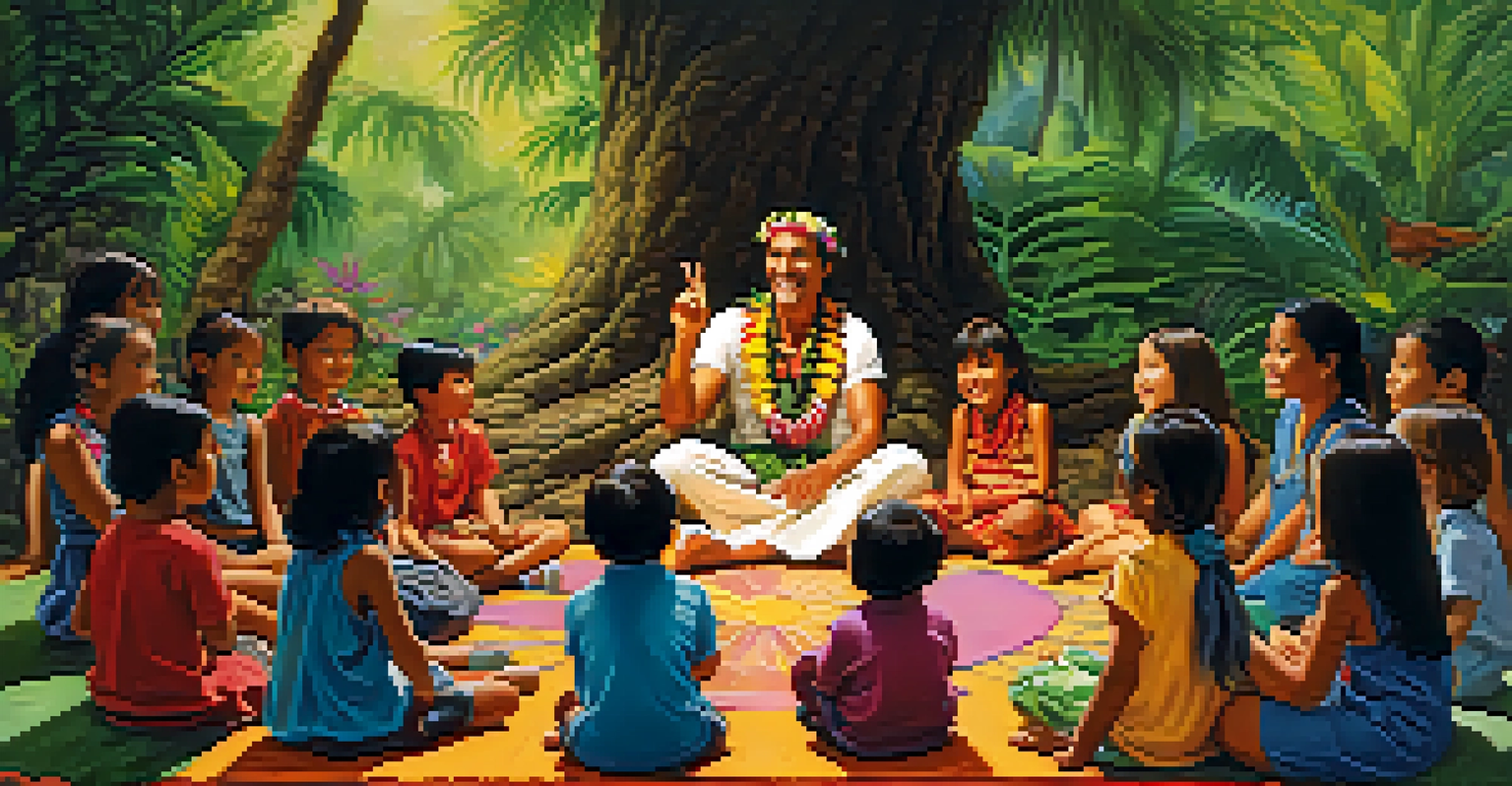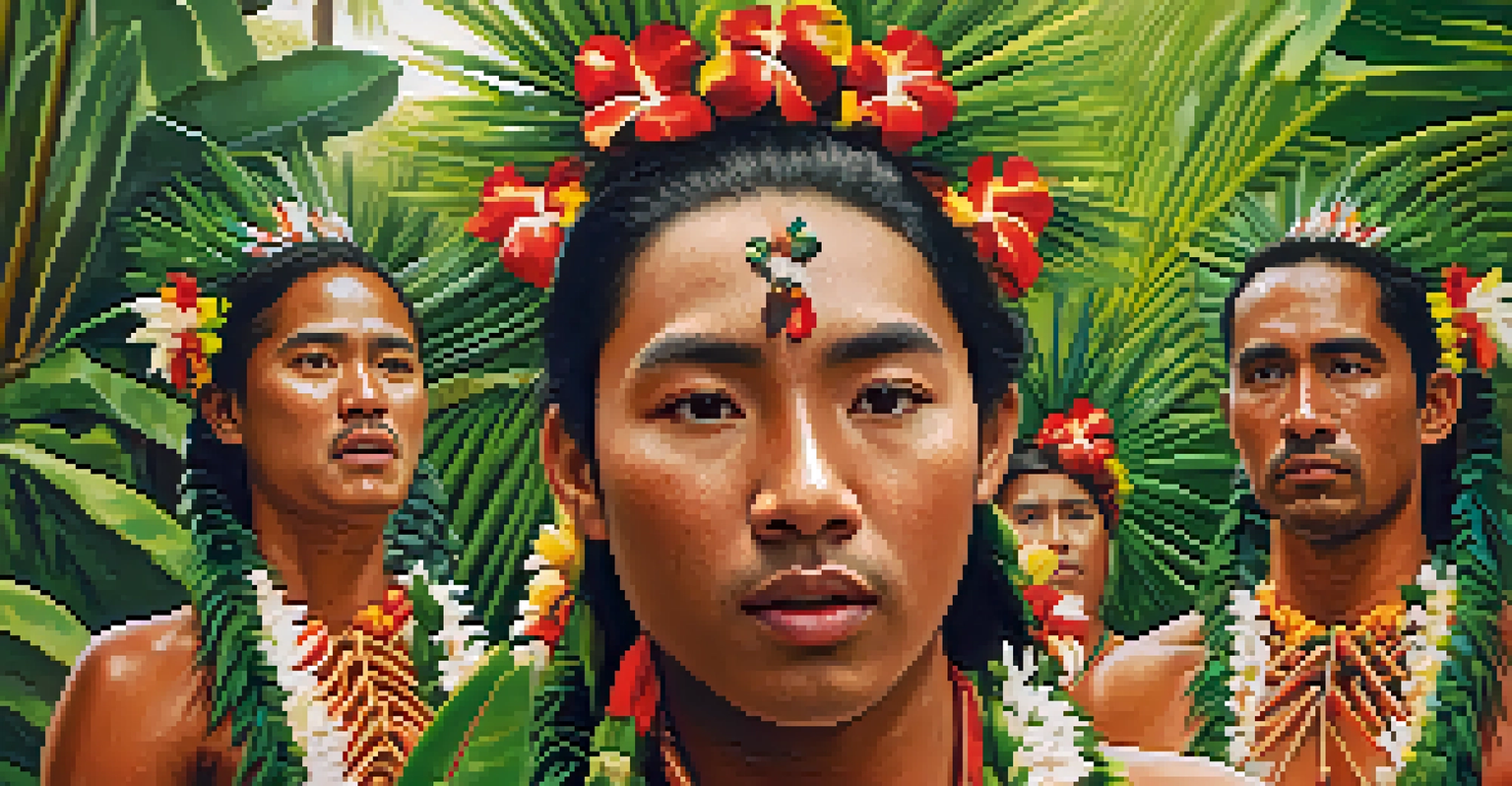Traditional Hawaiian Oral Literature: Myths, Legends, and More

Introduction to Hawaiian Oral Literature and Its Importance
Traditional Hawaiian oral literature is a vibrant tapestry woven from centuries of storytelling. It encompasses myths, legends, chants, and more, reflecting the rich cultural heritage of the Hawaiian Islands. These narratives were passed down through generations, serving not only as entertainment but also as a way to preserve history, values, and identity.
Stories can conquer all problems except for the ones we create for ourselves.
In a society where written language was introduced later, oral traditions became the primary means of sharing knowledge and preserving culture. Each story carried lessons about nature, gods, and human behavior, connecting the people to their environment and each other. This connection is still relevant today as Hawaii seeks to maintain its cultural integrity amidst modernization.
As we delve deeper into this captivating world, we will explore various aspects of Hawaiian oral literature, from its origins to its role in contemporary society. The stories not only entertain but also educate, making them a vital part of Hawaii's cultural fabric.
The Role of Myths in Hawaiian Culture
Myths in Hawaiian culture serve as foundational tales that explain the creation of the world, the origins of the Hawaiian people, and the nature of their gods. These stories often involve deities like Pele, the goddess of volcanoes, and Kanaloa, the god of the ocean. Each myth carries deep symbolic meanings and lessons that resonate with the values of the Hawaiian people.

For instance, the myth of Pele illustrates the relationship between humans and nature, emphasizing respect for the land and its forces. This not only teaches reverence for the environment but also highlights the importance of understanding one’s place in the world. Myths thus act as moral compasses, guiding individuals in their interactions with both the spiritual and physical realms.
Hawaiian Oral Literature Preserves Culture
Traditional Hawaiian oral literature is essential for preserving history, values, and identity through storytelling.
Moreover, these myths are not static; they evolve over time as they are retold by different generations. This adaptability ensures that they remain relevant and continue to impart wisdom to new audiences, reinforcing the idea that stories are living entities that grow with the people who share them.
Legends of Heroes and Historical Figures
Legends often focus on heroic figures and their adventures, illustrating the values and virtues upheld by Hawaiian society. Stories of warriors like Kamehameha the Great, who united the Hawaiian Islands, are not only about bravery but also about leadership, strategy, and community unity. These legends inspire pride and serve as models for future generations.
The stories we tell ourselves shape our identity and our culture.
In addition to historical figures, many legends revolve around cultural heroes who embody the spirit of the islands. These narratives often highlight their struggles and triumphs, emphasizing themes such as perseverance and the importance of family and community ties. Through these tales, listeners learn about the qualities that are valued in Hawaiian culture.
Legends also provide a glimpse into the history of the islands, preserving events and experiences that shaped the Hawaiian identity. They serve as a bridge connecting the past to the present, reminding the people of their roots and the legacy they carry forward.
The Art of Chanting: Oli and Mele
Chanting, or oli, is a fundamental aspect of Hawaiian oral literature, serving as a means of conveying stories, history, and cultural practices. Oli is often used in ceremonies, celebrations, and storytelling, where the rhythmic and melodic qualities enhance the message being shared. It creates a powerful connection between the performer and the audience, engaging listeners on multiple levels.
Mele, or songs, play a similar role, allowing for the expression of emotions, experiences, and cultural pride. These songs often recount historical events, celebrate love, or praise nature, showcasing the diverse themes present in Hawaiian literature. Through mele, the richness of the Hawaiian language is highlighted, as the lyrics often contain layers of meaning that reflect the depth of the culture.
Myths Teach Values and Respect for Nature
Hawaiian myths convey important lessons about the relationship between humans and nature, emphasizing respect and stewardship.
Both oli and mele are not merely artistic expressions; they are vital tools for preserving traditions and educating younger generations. By participating in these forms of oral literature, individuals contribute to the ongoing legacy of Hawaiian culture, ensuring that these cherished practices endure.
Lessons on Nature and Spirituality
Many stories within Hawaiian oral literature emphasize the relationship between humans and nature, showcasing the deep respect Hawaiians have for their environment. For instance, tales of the Hawaiian gods often personify natural elements, illustrating a belief system that sees the divine in the world around them. This perspective fosters a sense of stewardship and responsibility towards the land and its resources.
Through these narratives, listeners learn about the importance of balance and harmony in their interactions with nature. The stories serve as reminders that every action has consequences, encouraging a sustainable lifestyle that honors the earth. This connection to nature is not just a theme but a way of life for many in Hawaii, deeply rooted in the teachings of their ancestors.
Spirituality also plays a crucial role in these stories, as they often depict the interplay between the physical and spiritual realms. By exploring themes of mana (spiritual power) and the significance of rituals, these tales instill a sense of reverence for the unseen forces that guide and protect the community.
Contemporary Relevance of Hawaiian Oral Literature
In today's fast-paced world, Hawaiian oral literature remains relevant as a means of cultural preservation and identity reinforcement. With globalization and modernization posing challenges to traditional practices, storytelling serves as a powerful tool for revitalizing interest in Hawaiian culture. Community events, performances, and educational programs are helping to keep these stories alive.
Moreover, contemporary artists and writers are drawing inspiration from traditional narratives, blending them with modern themes to reach new audiences. This fusion not only honors the past but also ensures that Hawaiian oral literature evolves, resonating with younger generations. By integrating these stories into everyday life, the community fosters a sense of belonging and pride.
Contemporary Relevance of Storytelling
In today's world, Hawaiian oral traditions continue to thrive, adapting to modern themes while reinforcing cultural identity.
As more people recognize the value of cultural heritage, the demand for authentic storytelling continues to grow. This resurgence highlights the importance of oral traditions in shaping identity and community cohesion, affirming that these narratives are not relics of the past but living expressions of culture.
Conclusion: Celebrating Hawaiian Oral Traditions
In conclusion, traditional Hawaiian oral literature is a treasure trove of myths, legends, and teachings that encapsulate the essence of Hawaiian culture. These stories offer insights into the values, beliefs, and history of the Hawaiian people, making them an integral part of their identity. As we celebrate these traditions, we also honor the voices of those who came before us.
By sharing and engaging with these narratives, we contribute to the ongoing legacy of Hawaiian oral literature, ensuring that it continues to thrive in the modern world. Whether through storytelling, chanting, or song, each act of sharing reinforces the bonds of community and cultural pride. The stories are not just for entertainment; they are pathways to understanding and connection.

As we look to the future, let us appreciate and support the artists and storytellers who keep these traditions alive. In doing so, we not only celebrate Hawaiian culture but also enrich our own lives with the wisdom and beauty found in these timeless tales.